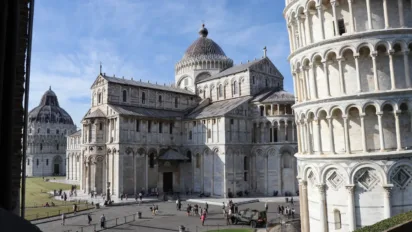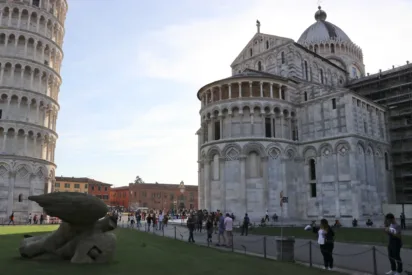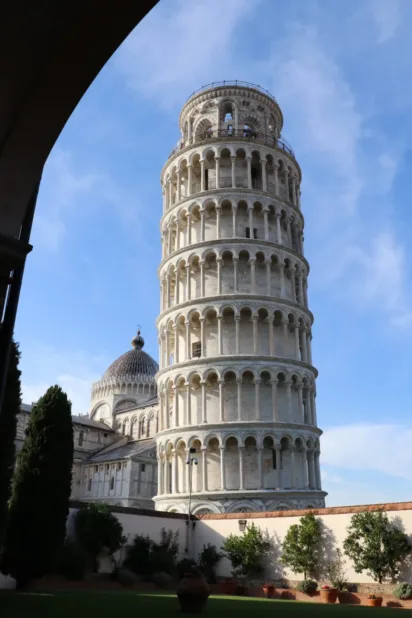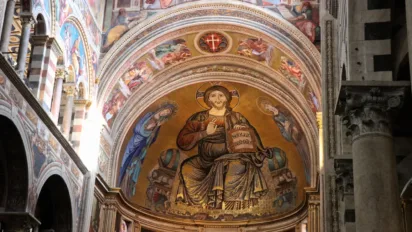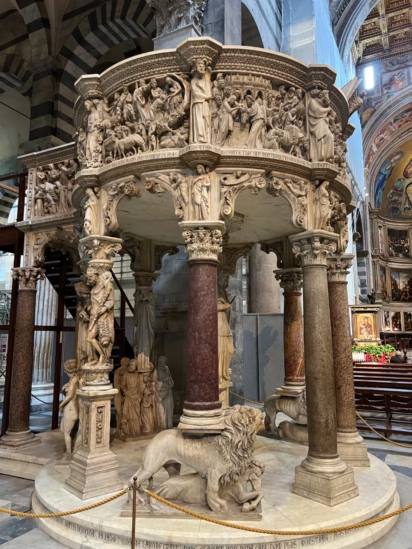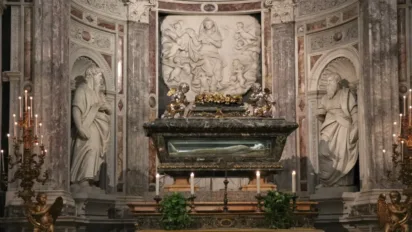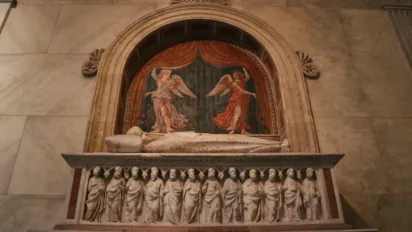Visit the Duomo in Pisa — a Romanesque masterpiece of white marble with black detailing and a cathedral filled with art. Admission is free but requires a time-slot reservation ticket.

Pisa Cathedral (Cattedrale Metropolitana Primaziale di Santa Maria Assunta or more commonly simply Duomo di Pisa) is best known for its campanile — the famous leaning tower of Pisa. However, this large marble church is a magnificent example of Romanesque architecture and is filled with art. Like the bell tower and baptistery, the church actually leans slightly too. Don’t admire it just from the outside, admission is free but requires a time-slot ticket.
Romanesque Pisa Cathedral
Construction of Pisa Cathedral started in 1064 on a Greek cross floorplan designed by Buscheto. It was consecrated in 1188. The church was soon after enlarged to plans by Rainaldo, who lengthened the nave to form the more typical Latin cross formed by a central nave with two side aisles on each side, an apse, and a protruding transept.
The original Romanesque style of Buschetto was followed when the church was enlarged but the western facade remains a source of debate. It was made by the sculptors Guglielmo (Wilhelm of Innsbruck) and Biduino but the exact date of completion is unclear. As a result, it is impossible to conclusively determine whether the use of the four-pillared loggias was an original inspiration or copied from other churches as far afield as Trier in Germany.
A major fire damaged the church in 1695. The 12th-century bronze doors by Bonnano on the western side were destroyed and replaced by 17th-century copies. The original 12th-century door in the transept facing the bell tower survived the fire but the current door is a copy too — the original by Bonnano, known as the St Rainerius door, is now on display in the cathedral museum.
Medieval Pisa was a seafaring and trading nation and the cathedral shows influences from all parts of the known world. Islamic architecture contributed to the airy feeling of the church with high lancet arches and alternating layers of white and black marble. Much of the church was financed from the spoils of wars with some art, including the griffin on the roof, simple war booty.
The statues and decorations on the outside of the church are mostly copies — the original works are now mostly inside the small cathedral museum.
Campanile – Leaning Tower of Pisa
The famous Leaning Tower of Pisa was never intended to be a defensive tower but rather the bell tower (campanile) for the adjacent cathedral — a function it still fulfills today in addition to being a major tourist attraction.
The tower is just over 58 m (190 ft) tall and currently inclines by around 5.5°. It has 207 capitals — most had to be replaced since its construction due to damage from especially thunderbolts in addition to the pressure of its leaning.
All the major buildings on the Field of Miracles in Pisa lean to some extent. Of course, it is easiest seen in the Leaning Tower but it is also fairly obvious in both the baptistery and cathedral.
It is 273 steps to the top of the campanile — access is by time-slot reservation tickets only. See Buy Online Tickets for the Leaning Tower of Pisa for details — reservations are best made well in advance, otherwise, try early morning or late in the day.
Interior of Pisa Cathedral

Much of the interior of Pisa’s Duomo was destroyed by a severe fire in 1595. The church is still filled with art but much is from the Baroque period — long after Pisa reached its financial and political zenith during the Middle Ages and early Renaissance. However, some early and original works did survive the inferno.
The interior of Pisa Cathedral is remarkably light and airy for a Romanesque cathedral. Windows are typically small but illumination is helped by the often bright Italian sunlight. The three series of windows behind the famous loggias in the western facade also allow light to flood in, especially in the afternoon. Islamic influences are also seen here with the high arches and the alternate use of white and black marble.
Of the large number of columns, note particularly the large granite ones between the nave and the apse. These are solid single stones and were taken from the mosque of Palermo as war booty in 1063.
The ceiling is typically flat as is usual in a Romanesque church but the ceiling of Pisa Cathedral was made after the fire of 1595. It is thus more Renaissance — coffered wood richly decorated with gold leaf in addition to painting. It not surprisingly bears the shield of the Medici family.
Paintings and Mosaics in Pisa Cathedral
As the church is dedicated to the assumption of Mary, the Madonna features heavily in the artwork. The large mosaic in the apse of Christ enthroned between the Virgin and Saint John survived the fire of 1595. St John’s face (1302) was the last work by Cimabue. The fresco of Mary and Child in the triumphal arch is similarly a medieval original.
The dome painting of Mary with saints is by Orazio and Girolamo Riminaldi. This early 17th-century work was recently restored.
Most of the other paintings, including nearly 30 in the galleries behind the altar, are from the period after the fire. It depicts mainly scenes from the life of Christ, Old Testament stories, and scenes from the lives of saints.
Giovanni Pisano Pulpit in the Duomo di Pisa

Arguably the most impressive art in the cathedral of Pisa is the pulpit made by Giovanni Pisano (1302-10). He clearly took inspiration from a similar pulpit in the nearby baptistery made earlier by his father Nicola.
The pulpit in the Duomo is the more complex. Not only does it contain many more figures (around 400 in total) but the side panels are slightly curved rather than the more traditional flat to give the pulpit a nearly round rather than polygonal appearance.
Like his father’s pulpit, this one shows scenes from the life of Christ and some columns use lions (symbol of the faithful) as base. As the pulpit in the baptistery, this one also contains a naked Hercules.
The episodes from the Life of Christ are:
- Annunciation, Visitation, and Birth of John (the Baptist)
- Nativity and Annunciation to the Shepherds
- Dream and Adoration by the Magi
- Presentation in the Temple and Flight to Egypt
- Massacre of the Innocents
- Kiss of Judas, Crowning with Thorns, Flagellation
- Crucifixion
- Last Judgment
An interesting element is using caryatides and Telemons rather than just simple columns. Nudes were rare in art in this period but here three face the congregation. Below the breastfeeding Ecclesia are the four cardinal virtues (justice, fortitude, temperance, and prudence). Prudence is a full female nude in the style of Venus Pudica. The adjacent Telemon is a butt-naked Hercules symbolizing strength.
[The first free-standing male nude since the end of the Roman era was only made three decades later — Donatello’s David (now in the Bargello Museum in Florence).]
This late medieval masterpiece survived the fire of 1595 but was dismantled soon after and only returned to the cathedral in 1926. Originally, it was probably positioned elsewhere in the church and the plain columns were donated by Mussolini to replace missing pieces. Art historians still debate whether it was put together correctly and whether the original had a marble staircase.

The modern marble pulpit and altar are from 2002 and considered controversial — too modern or simply not up to the artistic standard of the medieval masters?
Tombs in Pisa Cathedral
The Camposanto Cemetery is generally the pantheon for the great and good of Pisa but a few tombs are inside the cathedral as well. The two most famous are of St Rainerius and Emperor Henry VII.
The remains of St Rainerius, the patron saint of Pisa, are in a large tomb with a see-through glass side. His face was reconstructed following DNA analyses and the silver face mask is thus considered to be a close representation of the original. Rainerius was a local merchant who grew exceptionally rich but gave away all his wealth to live in poverty and devote his life to God. He died in 1160 and was canonized soon after.
The church once had a monumental tomb for Holy Roman Emperor Henry VII of Luxembourg who died of malaria in 1313. The tomb sculpted by Tino da Camaino was placed centrally in the transept to show Pisa’s support for the Ghibbeline cause. It was subsequently moved and fragmented for political and practical reasons. Only the marble coffin with Henry looking sideways remains in the church — the rest is now mostly in the cathedral museum and Camposanto cemetery.
According to legend, Galileo saw a light swinging in the wind after a door was opened during a service and subsequently formed his theory of isochronism of the pendulum. The large lamp at the crossing is often referred to as the Galileo lamp but it was produced a few years after Galileo published his theory. The earlier lamp was much simpler and smaller and now hangs in the Camposanto.
Pisa Cathedral Visitor’s Information

The tourist entry to Pisa Cathedral is from the west — doors facing the baptistery. Pick up free time-slot tickets from either ticket window (Sinopie Museum is the closer, otherwise behind the apsis near the Leaning Tower).
Buy Tickets for Sights in Pisa

Admission to the Field of Miracles (Campo Dei Miracoli) in Pisa and the exterior of all buildings in the area is free and possible at all times.
Tickets are available for the following sights in Pisa:
Cathedral (Duomo) — admission is free but only per time slot ticket. Pick up a free pass in person only from any ticket office. On very busy days, there may be a delay in entering the church or occasionally, no more free tickets available on the day. However, any of the paid tickets below automatically acts as a skip-the-line entry ticket to the duomo on the same day.
Climbing the Leaning Tower (Torre) — €20 per time-slot reservation tickets only. A combination pass with all other sites is around €30.
Baptistery (Battistero) / Camposanto Cemetery / Museum of the Sinopias (Museo delle Sinopie) / Museo dell’ Opera del Duomo (cathedral museum) — €7 for any site or great value at €10 for all sights.
Palazzo dell’ Opera del Duomo — admission depends on the exhibition, if any.
The two ticket offices at the Field of Miracles are inside the Sinopie Museum (near the Baptistery) and in the Palazzo dell’ Opera del Duomo (behind the church near the leaning tower).
Time-slot reservation tickets for the Leaning Tower of Pisa may be bought online at least a day in advance from Opapisa (tickets valid for a year so no refunds for any reason) or resellers such as Tiqets and Get Your Guide, which have much easier cancelation conditions. Opapisa sells tickets at most 20 days in advance while the resellers usually sell several months in advance. A variety of guided tours are available to see the sights on the Fields of Miracles of Pisa with many including climbing the leaning tower.
Opening Hours of Field of Miracles Sites in Pisa
The sights on the Field of Miracles in Pisa are open every day – exact times may be confirmed months in advance at the OpaPisa site.
All the sites are generally open as a minimum from 9:00 (10:00 for the Duomo) to 19:00. From April to September, the opening hours are usually 8:00 (10:00 for the Duomo) to 20:00 with the Camposanto and Tower open until 22:00 on some nights.
Last tickets are sold around half an hour before closing time (but expect an argument at the door if leaving it that late).
Combination tickets are valid for a year after the selected date so refunds are not given if a site is closed on a particular day(s).
More Information On Top Sights in Pisa
- See the Top Sights on Pisa’s Field of Miracles
- Tips on Buying Tickets and Tours for the Leaning Tower and Pisa Sights
- Visit the Duomo (Cathedral) of Pisa (Cattedrale)
- Visit the Baptistery of Pisa (Battistero)
- Visit the Cathedral Museum (Museo dell’ Opera del Duomo di Pisa)
- See Renaissance Frescoes in the Camposanto Cemetery
- Visit the Sinopie Museum in Pisa
- Transportation to the Leaning Tower of Pisa
- Book Guided Tours of Pisa and Day Trips at Get Your Guide
- Buy Tickets Online at Tiqets
- Book Italian Train and Intercity Bus Tickets at Omio
- More Photos of the Field of Miracles in Pisa on Flickr
